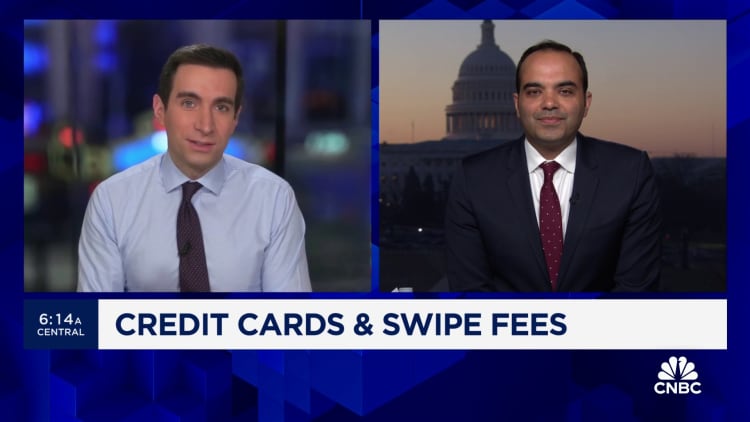Runstudio | The Image Bank | Getty Images
Credit card interest rates have ballooned to record highs in recent years â and the growing portion of the formula that generates profit for card issuers is partly to blame, according to a new analysis by the Consumer Financial Protection Bureau.
The average consumer paid a 22.8% interest rate on their credit card balance at the end of 2023, the highest since the Federal Reserve began tracking data in 1994.
Interest charges, expressed as an annual percentage rate, are up about 10 points in the past decade, from 12.9%. Total credit card debt and average balances are also at record highs.
“By some measures, credit cards have never been this expensive,” wrote CFPB’s Dan Martinez, senior credit card program manager, and financial analyst Margaret Seikel.
More from Personal Finance:
Here are some ways to maximize your financial aid for college
With mortgage rates high, renting is less expensive than buying
Here’s how to avoid unexpected fees with payment apps
Credit card issuers have raised ‘APR margins’
Credit card APRs began moving sharply higher in 2022 as the Fed raised its benchmark interest rate to tame inflation. Interest rates on credit cards â and other consumer loans â generally move in tandem with Fed policy, according to a barometer known as the “prime rate.”
However, credit card companies have also simultaneously raised their average “APR margin,” according to the CFPB.
APR margin is the difference between the total APR and the “prime rate.” It’s a proxy for card issuers’ profits commensurate with their lending risk, the CFPB said.
Those margins are at record highs. They averaged 14.3% in 2023, up from 9.6% in 2013, according to the watchdog’s analysis, issued Thursday.
Almost half the increase in total credit card interest rates in the past decade is due to issuers raising their APR margins, the analysis said.

However, the CFPB authors questioned if those higher profits were justified since issuers don’t seem to be taking more risk by extending credit to more consumers with lower credit scores, for example.
The share of consumers with “subprime” credit scores who hold a credit card has been “relatively stable,” they said.
Major credit card issuers got $25 billion in extra interest by raising their average APR margin over the last 10 years, the CFPB estimated. The average consumer with a $5,300 balance across credit cards would have paid an extra $250 in 2023 due to this increase, the agency said.
“Increases to the average APR margin … have fueled issuers’ profitability for the past decade,” Martinez and Seikel wrote. “Higher APR margins have allowed credit card companies to generate returns that are significantly higher than other bank activities.”
Risk may be a factor, too
The Consumer Bankers Association, a trade group that represents credit card and other financial companies, disputed the CFPB’s characterization of margins and profits.
“The CFPB claims that rising credit card interest rates over the past decade have been against a background of a ‘relatively stable share of cardholders with subprime credit scores,'” CBA president and CEO Lindsey Johnson said in a written statement. “This simply isn’t true.”
For example, about 42% of “deep subprime” borrowers had a credit card as of year-end 2022, its highest point since at least 2013, according to CFPB data. (“Deep subprime” borrowers have the worst credit relative to other groups. Their credit scores are below 580.)
“Lenders will only lend at a rate at which they’re compensated for the risk they’re taking,” said Greg McBride, chief financial analyst at Bankrate.
The shares of other “below-prime” borrowers (“near-prime” and “subprime” consumers) holding a credit card have been relatively flat for the past several years, according to CFPB data. (Their credit scores range from 580 to 659.)
Credit-card delinquencies may be an additional risk factor driving card issuers’ rationale to raise margins, McBride said.
For example, “serious” card delinquencies â payments that are 90 days or more overdue â have increased across all age groups, a signal of financial stress, according to the Federal Reserve Bank of New York.
About 9.7% of credit-card balances were seriously delinquent in Q4 2023, up from 7.7% a year earlier. While up in recent months, the current share of seriously delinquent balances is flat relative to 2013.
Industry concentration may also play a role
However, industry concentration is another reason card companies may have raised APR margins, McBride said.
“A greater concentration of market share does tend to produce greater pricing power,” he said. That’s also generally the case for all sorts of industries, including airlines and cable companies, he added.
Large lenders account for most of the credit card market: The 10 biggest control 83% of it, according to CFPB data.
There may be additional consolidation soon: This week, Capital One Financial announced a $35.3 billion acquisition of Discover Financial. They’re among the nation’s biggest credit card issuers. The merger still requires regulator approval.
How to manage credit card interest
There’s a way consumers can sidestep higher interest rates entirely. For instance, paying credit card bills on time and in full each month, according to experts.
In other words, don’t carry a balance. Such cardholders won’t pay interest. (Importantly, making a card’s minimum monthly payment doesn’t equate to paying one’s bill in full.)
Paying in full and on time each month is also a good way to raise one’s credit score, which may make lower-interest-rate cards available to consumers, McBride said.
Consumers with good credit may also be able to transfer an existing balance to a new credit card with a 0% APR introductory offer, McBride said. Some issuers are currently extending such 0% offers for up to 21 months, which “gives you quite a runway to get the debt paid off without the headwind of high interest rates,” he said.
Don’t miss these stories from CNBC PRO:

